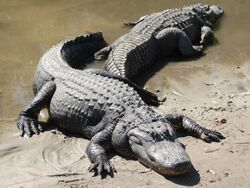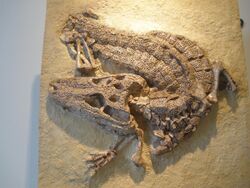Biology:Alligatoroidea
| Alligatoroidea | |
|---|---|

| |
| Alligators (shown above) and caimans are living members of the superfamily Alligatoroidea. | |
| Scientific classification | |
| Domain: | Eukaryota |
| Kingdom: | Animalia |
| Phylum: | Chordata |
| Class: | Reptilia |
| Clade: | Archosauromorpha |
| Clade: | Archosauriformes |
| Order: | Crocodilia |
| Superfamily: | Alligatoroidea Gray, 1844 |
| Subgroups | |
Alligatoroidea is one of three superfamilies of crocodylians, the other two being Crocodyloidea and Gavialoidea. Alligatoroidea evolved in the Late Cretaceous period, and consists of the alligators and caimans, as well as extinct members more closely related to the alligators than the two other groups.
Evolution
The superfamily Alligatoroidea is thought to have split from the crocodile-gharial lineage in the late Cretaceous, about 80 million years ago, but possibly as early as 100 million years ago based on molecular phylogenetics.[1][2][3] Leidyosuchus of Alberta is the earliest known genus. Fossil alligatoroids have been found throughout Eurasia as land bridges across both the North Atlantic and the Bering Strait have connected North America to Eurasia during the Cretaceous, Paleogene, and Neogene periods. Alligators and caimans split in North America during the early Tertiary or late Cretaceous (about 53 million[2] to about 65 million years ago[1]) and the latter reached South America by the Paleogene, before the closure of the Isthmus of Panama during the Neogene period. The Chinese alligator split from the American alligator about 33 million years ago[2] and likely descended from a lineage that crossed the Bering land bridge during the Neogene. The modern American alligator is well represented in the fossil record of the Pleistocene.[4] The alligator's full mitochondrial genome was sequenced in the 1990s.[5] The full genome, published in 2014, suggests that the alligator evolved much more slowly than mammals and birds.[6]
Phylogeny
Cladistically, Alligatoroidea is defined as Alligator mississippiensis (the American alligator) and all crocodylians more closely related to A. mississippiensis than to either Crocodylus niloticus (the Nile crocodile) or Gavialis gangeticus (the gharial).[7] This is a stem-based definition for alligators,[8] and is more inclusive than the crown group Alligatoridae.[9] As a crown group, Alligatoridae only includes the last common ancestor of all extant (living) alligators, caimans, and their descendants (living or extinct), whereas Alligatoroidea, as a stem group, also includes more basal extinct alligator ancestors that are more closely related to living alligators than to crocodiles or gavialids. When considering only living taxa (neontology), this makes Alligatoroidea and Alligatoridae synonymous, and only Alligatoridae is used. Thus, Alligatoroidea is only used in the context of paleontology.
Traditionally, crocodiles and alligators were considered more closely related and grouped together in the clade Brevirostres, to the exclusion of the gharials. This classification was based on morphological studies primarily focused on analyzing skeletal traits of living and extinct fossil species.[10] However, recent molecular studies using DNA sequencing have rejected Brevirostres upon finding the crocodiles and gavialids to be more closely related than the alligators.[11][12][13][9][14] The new clade Longirostres was named by Harshman et al. in 2003.[11]
A 2018 tip dating study by Lee & Yates simultaneously using morphological, molecular (DNA sequencing), and stratigraphic (fossil age) data established the inter-relationships within Crocodilia,[9] which was expanded upon in 2021 by Hekkala et al. using paleogenomics by extracting DNA from the extinct Voay.[14]
The below cladogram shows the results of the latest study:
| Crocodylia |
| ||||||||||||||||||||||||||||||||||||||||||||||||||||||||||||||||||||||||||||||||||||||||||||||||
| (crown group) |
References
- ↑ 1.0 1.1 Oaks, J.R. (2011). "A time-calibrated species tree of Crocodylia reveals a recent radiation of the true crocodiles". Evolution 65 (11): 3285–3297. doi:10.1111/j.1558-5646.2011.01373.x. PMID 22023592.
- ↑ 2.0 2.1 2.2 Pan, T.; Miao, J.-S.; Zhang, H.-B.; Yan, P.; Lee, P.-S.; Jiang, X.-Y.; Ouyang, J.-H.; Deng, Y.-P. et al. (2020). "Near-complete phylogeny of extant Crocodylia (Reptilia) using mitogenome-based data". Zoological Journal of the Linnean Society 191 (4): 1075–1089. doi:10.1093/zoolinnean/zlaa074.
- ↑ Rio, J. P.; Mannion, P. D. (2021). "Phylogenetic analysis of a new morphological dataset elucidates the evolutionary history of Crocodylia and resolves the long-standing gharial problem". PeerJ 9: e12094. doi:10.7717/peerj.12094. PMID 34567843.
- ↑ Brochu, Christopher A. (1999). "Phylogenetics, Taxonomy, and Historical Biogeography of Alligatoroidea". Society of Vertebrate Paleontology Memoir 6: 9–100. doi:10.2307/3889340.
- ↑ Janke, A.; Arnason, U. (1997). "The complete mitochondrial genome of Alligator mississippiensis and the separation between recent archosauria (birds and crocodiles)". Molecular Biology and Evolution 14 (12): 1266–72. doi:10.1093/oxfordjournals.molbev.a025736. PMID 9402737.
- ↑ "Three crocodilian genomes reveal ancestral patterns of evolution among archosaurs". Science 346 (6215): 1254449. 2014. doi:10.1126/science.1254449. PMID 25504731.
- ↑ Brochu, Christopher A. (May 2003). "Phylogenetic approaches toward crocodylian history". Annual Review of Earth and Planetary Sciences 31 (31): 360. doi:10.1146/annurev.earth.31.100901.141308. Bibcode: 2003AREPS..31..357B.
- ↑ Tobias Massonne; Davit Vasilyan; Márton Rabi; Madelaine Böhme (2019). "A new alligatoroid from the Eocene of Vietnam highlights an extinct Asian clade independent from extant Alligator sinensis". PeerJ 7: e7562. doi:10.7717/peerj.7562. PMID 31720094.
- ↑ 9.0 9.1 9.2 Michael S. Y. Lee; Adam M. Yates (27 June 2018). "Tip-dating and homoplasy: reconciling the shallow molecular divergences of modern gharials with their long fossil". Proceedings of the Royal Society B 285 (1881). doi:10.1098/rspb.2018.1071. PMID 30051855.
- ↑ Holliday, Casey M.; Gardner, Nicholas M. (2012). Farke, Andrew A. ed. "A new eusuchian crocodyliform with novel cranial integument and its significance for the origin and evolution of Crocodylia". PLOS ONE 7 (1): e30471. doi:10.1371/journal.pone.0030471. PMID 22303441. Bibcode: 2012PLoSO...730471H.
- ↑ 11.0 11.1 Harshman, J.; Huddleston, C. J.; Bollback, J. P.; Parsons, T. J.; Braun, M. J. (2003). "True and false gharials: A nuclear gene phylogeny of crocodylia". Systematic Biology 52 (3): 386–402. doi:10.1080/10635150309323. PMID 12775527. http://si-pddr.si.edu/bitstream/handle/10088/6275/2003C_Harshman_et_al.pdf. Retrieved 2021-07-20.
- ↑ Gatesy, J.; Amato, G. (2008). "The rapid accumulation of consistent molecular support for intergeneric crocodylian relationships". Molecular Phylogenetics and Evolution 48 (3): 1232–1237. doi:10.1016/j.ympev.2008.02.009. PMID 18372192.
- ↑ Erickson, G. M.; Gignac, P. M.; Steppan, S. J.; Lappin, A. K.; Vliet, K. A.; Brueggen, J. A.; Inouye, B. D.; Kledzik, D. et al. (2012). Claessens, Leon. ed. "Insights into the ecology and evolutionary success of crocodilians revealed through bite-force and tooth-pressure experimentation". PLOS ONE 7 (3): e31781. doi:10.1371/journal.pone.0031781. PMID 22431965. Bibcode: 2012PLoSO...731781E.
- ↑ 14.0 14.1 Hekkala, E.; Gatesy, J.; Narechania, A.; Meredith, R.; Russello, M.; Aardema, M. L.; Jensen, E.; Montanari, S. et al. (2021-04-27). "Paleogenomics illuminates the evolutionary history of the extinct Holocene "horned" crocodile of Madagascar, Voay robustus" (in en). Communications Biology 4 (1): 505. doi:10.1038/s42003-021-02017-0. ISSN 2399-3642. PMID 33907305.
Wikidata ☰ Q507496 entry
 |




